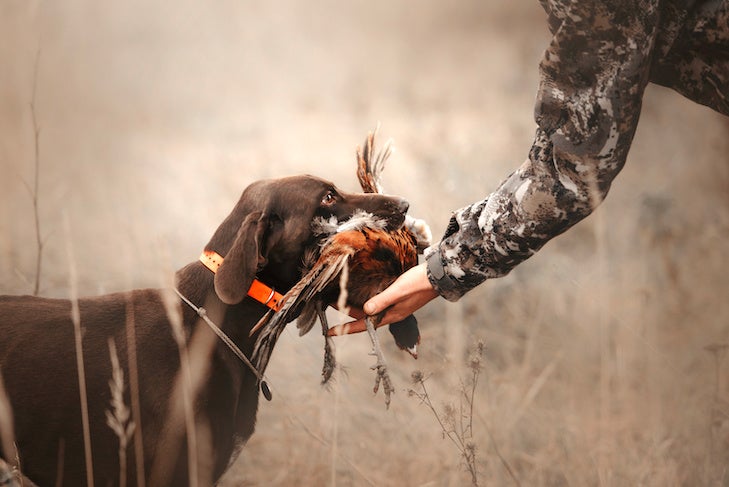
Hunting With Dogs: Training & Safety Tips
Hunting with dogs is an exciting way to experience outdoor life together. With a little bit of work and effort you can safely traverse the outdoors and go hunting with your dog during the autumn and winter months. Dogs have been hunting with humans for millennia. Many hunting breeds were actually developed specifically to find, flush out, or retrieve game. But that doesn’t mean that your dog will automatically know what to do on a hunt.
Before you head out in search of game with your dog, you’ll need to train them. Aside from helping you find and retrieve the quarry you’re after, dogs also must become used to loud sounds like gunshots. You’ll also need to bring along the proper hunting gear necessary to keep your dog safe and satisfied in the field.
Get Your Dog Used to Gunshots
Gunshots are loud, and the sound can spook your dog into running off in the middle of a hunt. A gun-shy dog is not born, it is created, and once the damage is done, gun-shyness can prove virtually impossible to completely “cure.” That’s why gun training is so important.
A simple way to train their dogs by running retriever drills for dogs is to toss a decoy “bumper” for the dogs to fetch. At the same time, to start with, have someone else fire a gun 100 yards away. The shooter fires a shot as the dog leaves to make a retrieve. With each retrieve, the shooter eases closer from behind the handler and dog.

Reward your dog as they slowly get used to the shots. Continue the process gradually, until the gunner is eventually right beside the dog when shooting.
Train Your Dog to Help Locate Game
Obedience is the keystone that all other training is built off. If a dog won’t do a sit/stay for a short period of time on a stand, then there is no way that they’ll have the control to sit through an exciting duck hunt.
It is very important to start obedience training when your dog is 8 weeks old. It is recommend to start retrieval training when they’re 6 to 7 months old. By this point, your dog will have the necessary skills and physical ability to handle more demanding tasks.
When teaching dogs to find and flush out game, try running quartering drills regularly. Quartering drills teach your dog to run back and forth ahead of you in a zigzag pattern. This allows them to locate more game than walking in a straight line. You can set up bumpers to guide your dog in this pattern, and use slight arm movements to help guide your dog. After the dog approaches each bumper, praise your dog or give them a tasty treat.
Train Your Dog to Retrieve Game
An excellent way to train your hunting dogs to retrieve game is to simulate a hunting scenario using decoys. Repeat the training on land and in water. This helps dogs get acclimated to different kinds of terrain.
A tried a true technique is to have a bird boy one hundred or so yards out in a field blow a duck call and catapult a bumper into the air so that the dog sees it fall. The dog then runs out and brings back the bumper. Eventually, the dog learns to watch the sky for falling birds and to mark their location so that your dog knows where to find them for the retrieve.
Blind retrieve training is also critical, since it allows you to guide a dog to a fallen bird that they might not have seen fall. Perfecting blind training can be challenging, but learning to guide your dog by using a series of dog whistles and/or hand signals makes for a more successful hunting trip.
Test Hunting Skills and Reinforce Training
Before hunting with dogs, consider participating in Retriever Field Trials and hunting tests. Hunt tests help show you how well your dog will perform in the field. Field trials, meanwhile, let more experienced dogs show off their skills on the hunt. Plus, the events are geared towards the unique skills of different breeds, including Pointers, Retrievers, and Spaniels. These hunt-focused events ensure that your dogs are ready for the hunt and help keep dogs active and in shape during the off-season.

Pack Proper Hunting Supplies
While hunting with dogs, you’ll need to bring along some gear to keep them comfortable and safe. It’s always a good idea to put your dog in an easily-seen orange safety vest. That way, other hunters can easily spot them.
Have a first-aid kit filled with bandaging material, wound care items, and other emergency supplies. For waterfowl hunting, a buoyant vest is a great idea as well. Providing their own hunting blind and elevated stand to stay warm and safe in the elements is always a special treat for your dog, too. Take plenty of supplies to keep your dog well-fed and hydrated.
You don’t have to stay indoors with your dog during hunting season. With some knowledge of your surroundings, off season training, and having the proper supplies on hand, you can have a safe, active, and enjoyable hunting season with your canine companion.
